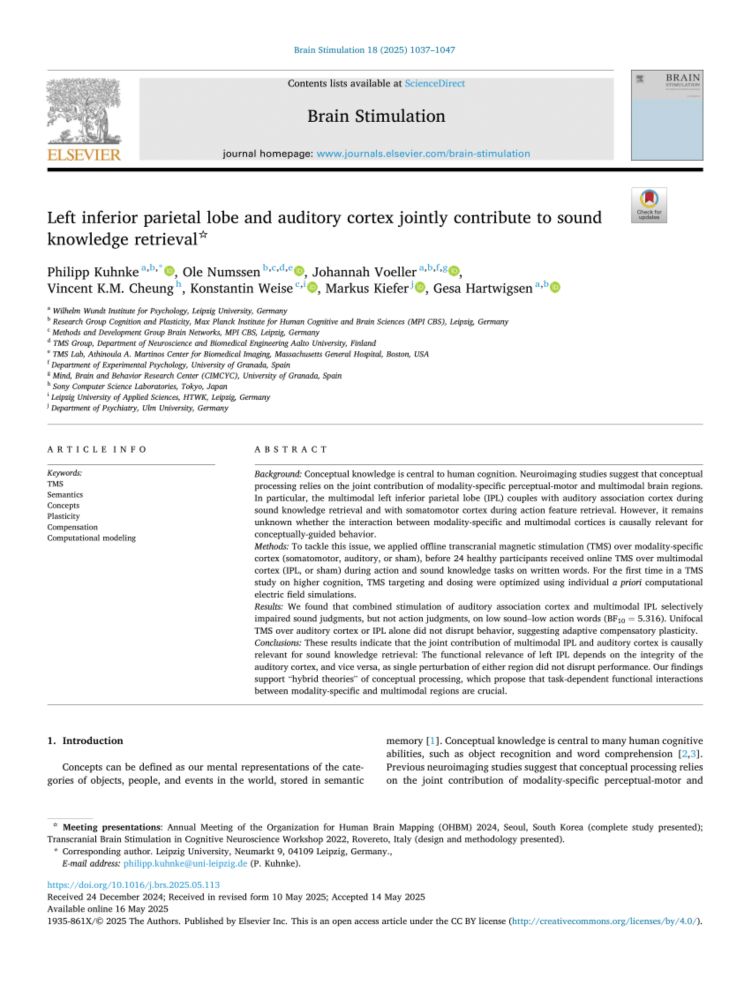Philipp Kuhnke
@philkuhnke.bsky.social
600 followers
1.2K following
21 posts
Cognitive neuroscientist @ Uni Leipzig and MPI CBS working on conceptual-semantic knowledge, mainly using fMRI and TMS.
Posts
Media
Videos
Starter Packs
Pinned
Philipp Kuhnke
@philkuhnke.bsky.social
· May 24

(PDF) Left inferior parietal lobe and auditory cortex jointly contribute to sound knowledge retrieval
PDF | Background Conceptual knowledge is central to human cognition. Neuroimaging studies suggest that conceptual processing relies on the joint... | Find, read and cite all the research you need on R...
www.researchgate.net
Philipp Kuhnke
@philkuhnke.bsky.social
· May 24
Philipp Kuhnke
@philkuhnke.bsky.social
· May 24

(PDF) Left inferior parietal lobe and auditory cortex jointly contribute to sound knowledge retrieval
PDF | Background Conceptual knowledge is central to human cognition. Neuroimaging studies suggest that conceptual processing relies on the joint... | Find, read and cite all the research you need on R...
www.researchgate.net
Philipp Kuhnke
@philkuhnke.bsky.social
· Apr 24

The ‘reading’ brain: Meta-analytic insight into functional activation during reading in adults
Literacy provides the key to social contacts, education, and employment, and significantly influences well-being and mental health. Summarizing 163 st…
www.sciencedirect.com
Reposted by Philipp Kuhnke
Sandra Martin
@drsandramartin.bsky.social
· Apr 23

Causal Contributions of Left Inferior and Medial Frontal Cortex to Semantic and Executive Control
Semantic control guides the targeted and context-based retrieval from semantic memory. The overlap with and dissociation from domain-general executive control in the frontal lobe remains contentious. ...
doi.org
Philipp Kuhnke
@philkuhnke.bsky.social
· Apr 22

Comparison of whole-brain task-modulated functional connectivity methods for fMRI task connectomics - Communications Biology
Large-scale neural mass simulations revealed best task-modulated functional connectivity methods for different fMRI designs and fundamental limitations for detecting rapid modulations of neural synchr...
doi.org
Reposted by Philipp Kuhnke
Reposted by Philipp Kuhnke
Philipp Kuhnke
@philkuhnke.bsky.social
· Feb 21

New insights into the mechanisms of language recovery after stroke
A new study shows how the brain reorganises itself in the first few months after a stroke to improve the ability to speak again. The findings will help researchers understand how functional networks w...
www.uni-leipzig.de
Reposted by Philipp Kuhnke
Reposted by Philipp Kuhnke
Reposted by Philipp Kuhnke
Reposted by Philipp Kuhnke
Reposted by Philipp Kuhnke
Reposted by Philipp Kuhnke
hakwan lau
@hakwan.bsky.social
· Jan 23
Philipp Kuhnke
@philkuhnke.bsky.social
· Jan 23
Philipp Kuhnke
@philkuhnke.bsky.social
· Jan 23
Philipp Kuhnke
@philkuhnke.bsky.social
· Jan 22

Meta-analytic evidence for a novel hierarchical model of conceptual processing
Conceptual knowledge plays a pivotal role in human cognition. Grounded cognition theories propose that concepts consist of perceptual-motor features r…
www.sciencedirect.com











